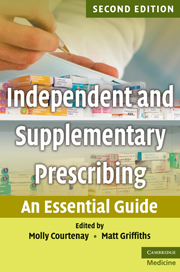Book contents
- Frontmatter
- Contents
- List of contributors
- Foreword to the second edition
- Preface to the second edition
- 1 Non-medical prescribing: an overview
- 2 Non-medical prescribing in a multidisciplinary team context
- 3 Consultation skills and decision making
- 4 Legal aspects of independent and supplementary prescribing
- 5 Ethical issues in independent and supplementary prescribing
- 6 Psychology and sociology of prescribing
- 7 Applied pharmacology
- 8 Monitoring skills
- 9 Promoting concordance in prescribing interactions
- 10 Evidence-based prescribing
- 11 Extended/supplementary prescribing: a public health perspective
- 12 Calculation skills
- 13 Prescribing in practice: how it works
- 14 Minimising the risk of prescribing error
- Index
- References
10 - Evidence-based prescribing
Published online by Cambridge University Press: 10 January 2011
- Frontmatter
- Contents
- List of contributors
- Foreword to the second edition
- Preface to the second edition
- 1 Non-medical prescribing: an overview
- 2 Non-medical prescribing in a multidisciplinary team context
- 3 Consultation skills and decision making
- 4 Legal aspects of independent and supplementary prescribing
- 5 Ethical issues in independent and supplementary prescribing
- 6 Psychology and sociology of prescribing
- 7 Applied pharmacology
- 8 Monitoring skills
- 9 Promoting concordance in prescribing interactions
- 10 Evidence-based prescribing
- 11 Extended/supplementary prescribing: a public health perspective
- 12 Calculation skills
- 13 Prescribing in practice: how it works
- 14 Minimising the risk of prescribing error
- Index
- References
Summary
According to Sackett et al. (1996) evidence-based healthcare is: ‘judiciously and conscientiously applying the best evidence to prevent, detect and treat disorders’.
This is an ambitious statement as the barriers to disseminating and applying evidence are both numerous and multifaceted.
The discipline of evidence-based medicine (EBM) is relatively new to nurses; traditionally they have based their clinical decisions on a combination of experience, observation, opinion, published material and personal research (Trinder and Reynolds 2000). The introduction of clinical governance, which emphasises accountability, quality and efficiency, has challenged this approach and it is no longer acceptable to base clinical decisions on personal opinion. Decision making must be evidence-based.
Prescribing is only one stage in making a rational treatment decision. Other stages include drawing on individual clinical expertise, taking account of patient choice and considering available resources. This needs to follow a ‘step-wise’ approach, starting with defining the patient's problem, which requires specific clinical skills and expertise, including undertaking a detailed history and physical examination, interpreting test results etc. In some circumstances, treatment may be initiated before a firm diagnosis has been made. In this situation, the clinician has to draw upon the best information available at the time and their knowledge of the patient.
It is essential that the patient is involved in making the treatment decisions. The patient's beliefs, expectations and preferences should be identified and acknowledged alongside existing clinical evidence. If a treatment is unacceptable to a patient, they are unlikely to adhere to the regime.
Evidence-based clinical practice is an approach to decision making.
- Type
- Chapter
- Information
- Independent and Supplementary PrescribingAn Essential Guide, pp. 119 - 129Publisher: Cambridge University PressPrint publication year: 2010



